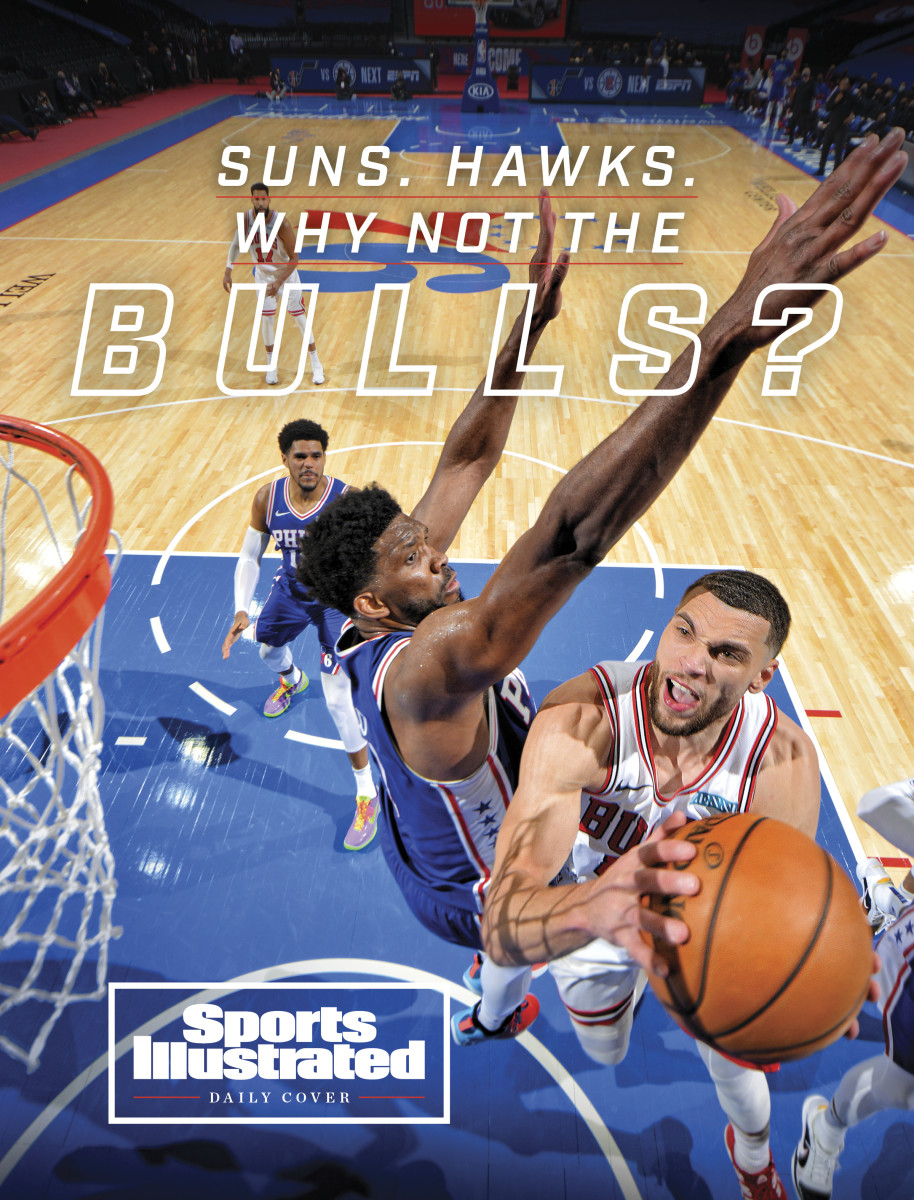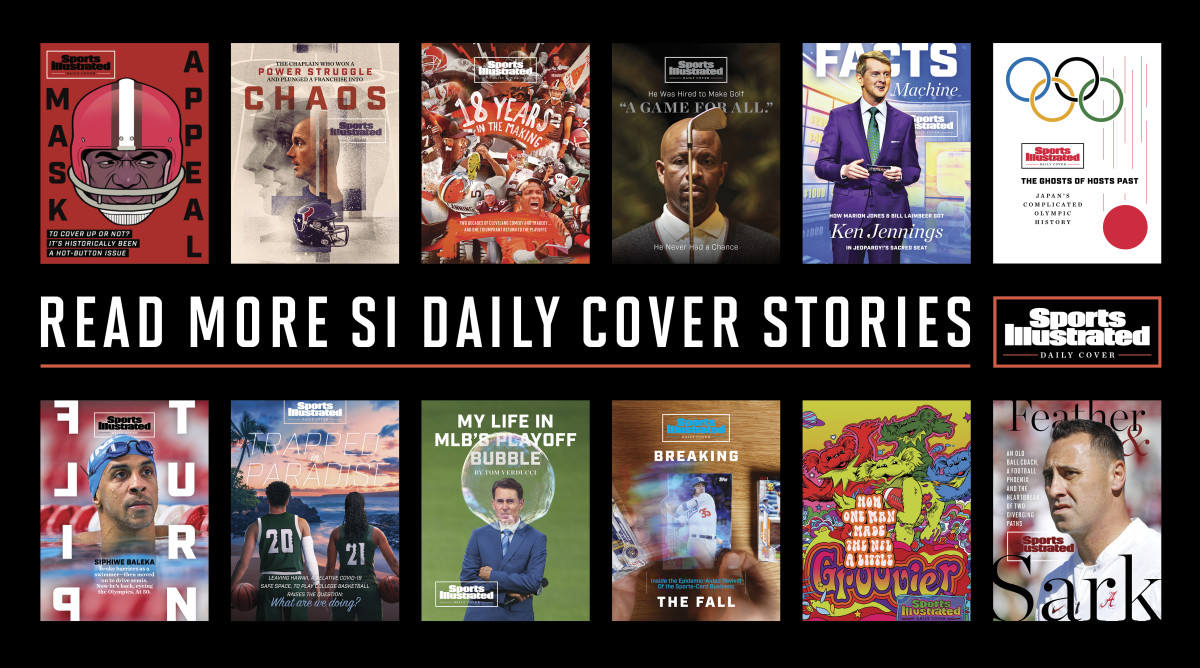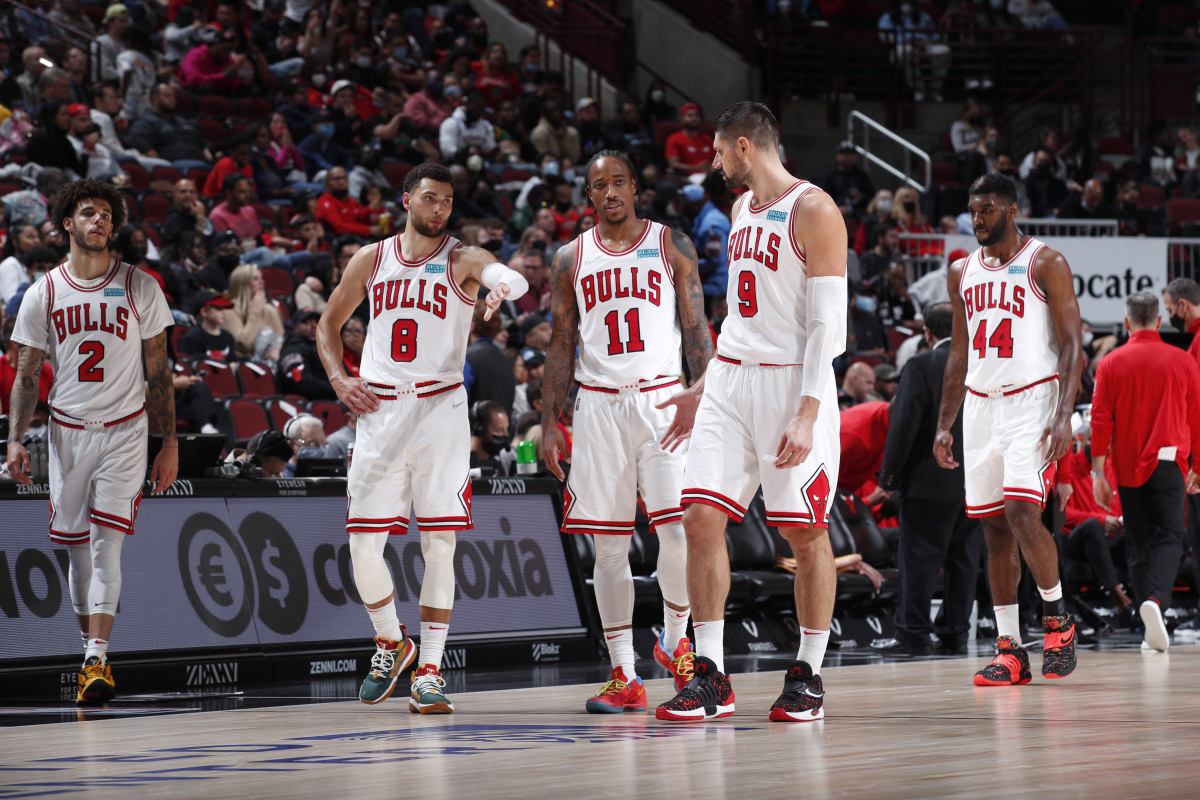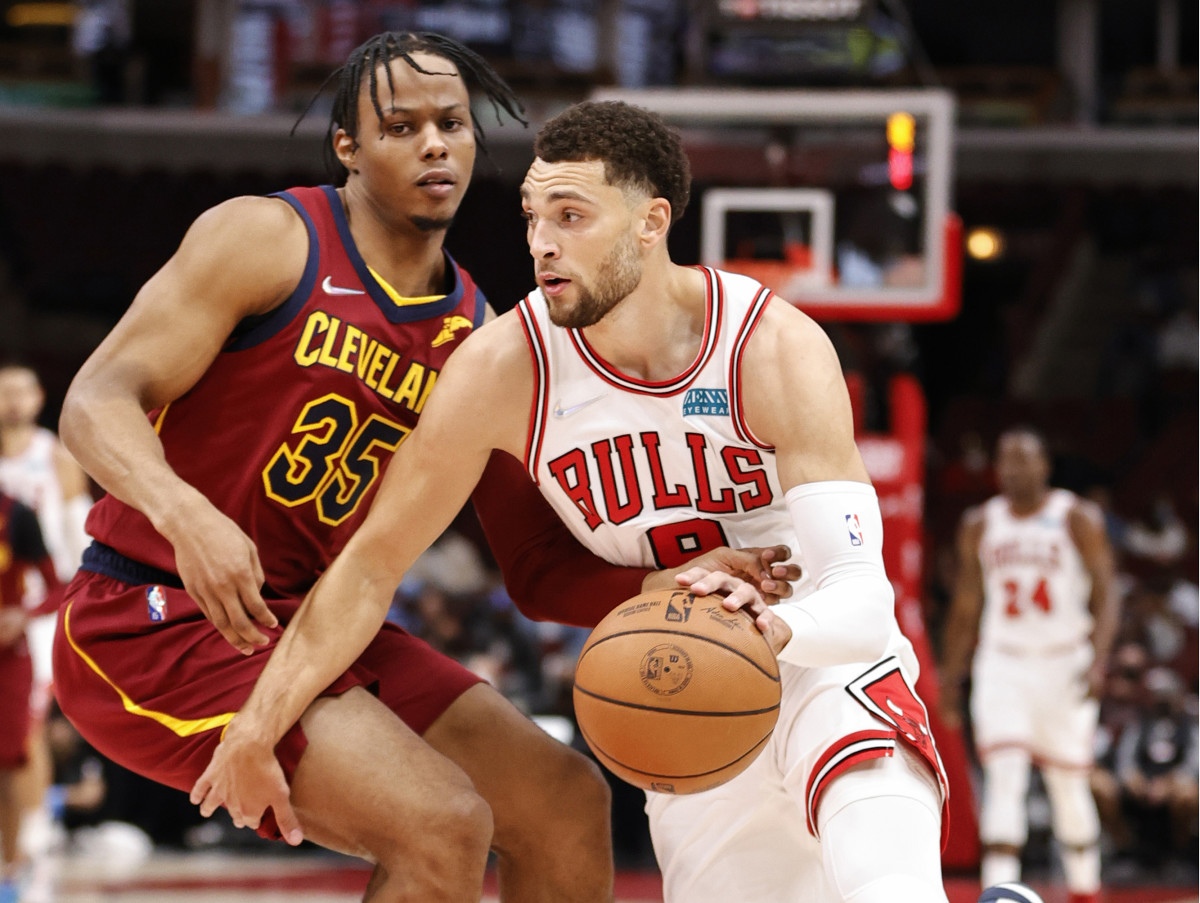How Chicago Became the NBA's Most Intriguing Team
Perhaps the best way to tell the story of the Chicago Bulls the past few years is through the eyes of Alfonso Avila.
The Cicero, Ill., native, who works primarily as a mover, hustles as a specialty T-shirt vendor on game nights outside the United Center. But his side gig—which he’s done at multiple stadiums for two decades now—was once far more full of life than it is at the moment.
Scores of bucket boys, who’d use buckets as percussive instruments, used to perform along the sidewalks, mere feet from the famed Michael Jordan statue, in hopes of garnering donations. Saxophone players would do the same, playing jazz tunes late into the night, creating an atmosphere just as good as the world-class basketball spectators had seen inside the stadium.
At some point, though, what was once a lively, rhythmic environment devolved into the blues. And now, there’s no music—or postgame life, really—at all outside the hallowed arena.
The consistent losing eventually killed it off.
“The ambience just kind of died down—it’s not here anymore,” says Avila, who was on the corner of Madison and Wood dressed in a full Michael Myers costume, hawking $20 Halloween shirts that read NO LIVES MATTER. “People always come out to games in bigger numbers when the team is winning. And people are way happier, and more drunk, when the team is winning. So after Derrick [Rose] hurt his knee, and Jimmy [Butler] left town, that was kind of it. [The postgame routine] wasn’t the same anymore.” (The rebuilding Blackhawks, who share the stadium with the Bulls, haven’t exactly helped matters, either. Meanwhile, the Chicago Sky—who won their first WNBA championship on Sunday—play in a separate arena six miles southeast of the west side venue.)

Since the United Center’s 1990s heyday, when Jordan and the Bulls were arguably the biggest story in the sports world, there’s been only one true stretch of contention from about 2010 to '15, when Chicago reached the conference finals and looked capable of doing battle against Miami’s Big Three. But then the franchise saw its window evaporate when Chicago native and Bulls MVP Derrick Rose’s knee troubles made him a different player. Rose and star wing Jimmy Butler failed to jell as a duo, and after making Butler their leading man, the Bulls eventually dealt him away in the summer of '17. Since then, the Bulls have won an NBA-worst 33.9% of their ballgames—and have no sexy draft pick to show for their struggles. The past four years, Chicago hasn’t hibernated as much as it’s gone comatose.
All of which explains why this moment, with the sleeping giant of a franchise pushing its chips into the middle of the table, feels so different. If this was a car, Chicago just went from being parked to driving in fourth gear, without ever going into neutral.
This summer, the new regime led by Bulls vice president Arturas Karnisovas and general manager Marc Eversley took a Big Hurt-sized swing in free agency, landing not only point guard Lonzo Ball for four years and $80 million, but also four-time All-Star DeMar DeRozan in a sign-and-trade for three years and $85 million. They’ll play next to two-time All-Star center Nikola Vucevic—a highly skilled big who averaged 23.4 points and 11.7 boards last season—whom the Bulls traded for in March.
The group looks even more formidable considering they’ll be anchored by 26-year-old All-Star Zach LaVine—the key piece Chicago got back for Butler—who’s coming off a career year in which he averaged 27.4 points, 5.0 boards and 4.9 assists on the best efficiency he’s ever had.
The Bulls are suddenly intriguing. But it’s an open question as to whether “intriguing” is the same as “ready to contend.” The takes on the Bulls have been a bit polarizing, to say the least, with some analysts feeling the aggressive moves were exactly what the organization needed to potentially take the next step, and others feeling the commitments might have handcuffed Chicago into nothing more than a basement of mediocrity.
Usually, when a team adds a pair of All-Star caliber pieces in short order—Kevin Durant and Kyrie Irving, or Kawhi Leonard and Paul George come to mind—it’s cause for the entire NBA world to stop and take notice. But that’s just it: while the Bulls added stars, unlike the Nets and Clippers, they didn’t add ones of the show-stopping variety. Chicago has three top-50 players, but all three likely fall in the bottom half of that group, leaving them without a true superstar—which is still the key ingredient most feel is necessary to win an NBA championship.

The Bulls will be a test case for an interesting experiment this season: can the lack of one superstar be made up for with a trio of highly talented, yet smaller stars?
The pieces around LaVine, who’s in line to become an unrestricted free agent after the season, mark a completely different scenario than the one the All-Star guard walked into last year. Back then, an argument could be made that veteran role player and versatile sage Thaddeus Young was the team’s second-best player. Beyond all that, this year—LaVine’s eighth as a professional—will somehow be the first time he’ll start a season with the same coach he began the last one with. The entire situation is akin to a child going from having coal one Christmas to having a living room full of toys the next.
“The stuff I’ve been used to, it’s been hectic. New teammates and new coaches every year. I’ve had to figure out how to grow my game with the chaos, really,” says LaVine, who, prior to the recent Summer Olympics, hadn’t experienced a four-game winning streak since his days at UCLA. “This is the most excited I’ve ever been here. To understand that we’re going to be out here really competing, with goals set? It’s a good feeling.”
What those goals are exactly, LaVine and his teammates are careful not to say publicly. At the same time, it’s clear this wasn’t a roster put together in hopes of merely sniffing .500. LaVine and the Bulls would almost certainly be left with that lump-of-coal feeling on Christmas again if there’s no playoff payoff at the end of the journey.
You have to go back five years to remember the last time the Bulls made a splash, or whatever you would opt to call the free-agent signings they made back in 2016.
Yes, there was some buzz when an aging Dwyane Wade left Miami to sign with his hometown Bulls. Rajon Rondo signed, too, and would suit up next to Butler. Just one problem: just months earlier—days earlier—the team’s front office had publicly committed to rebuilding around Butler by going younger. So for as glitzy as everything looked, the plan wasn’t all that coherent, and came with the sort of bumps one might expect when mixing old and young.
Despite its status as a big market, and one of the league’s iconic franchises, it’s not often that Chicago makes headlines in free agency. For awhile, during Jordan’s reign, the franchise didn’t have to. Then came the Baby Bulls who built through the draft. And the Rose era, which mixed homegrown talent with occasional free agents, like Carlos Boozer or Rip Hamilton.
During this latest four-year lull, there hasn’t been much of note aside from LaVine’s ascent. The lack of pizazz, plus losing, meant fewer fans watching on TV, and far more empty seats—something the franchise never had to worry about when there was a season-ticket waiting list 25,000 people long at the turn of the century. Between 2016 and 2020, the Bulls experienced a free fall, dropping from first to 24th in NBA home attendance percentage.
But fans are curious creatures. When something outside the norm happens, it piques their interest. If they dozed off at some point during the Bulls’ struggles in recent years, the trade for Vucevic brought them back to consciousness. The signing of Ball and key Lakers backup Alex Caruso got many of them to sit up straight. Then the DeRozan deal prompted them to stand.
“For me, I think it’s just seeing the front office finally being proactive, and choosing a direction,” says Zach Jacobs, 28, a suburban Deerfield resident who works in third-party logistics and just recently purchased season tickets for the first time. “[The decision to buy] was a domino effect. They kept getting guys you could get excited about. As a fan, you know when a roster’s being built to make a run at something verus a roster where [the front office is] just hoping to find a player or two they can keep around for the next year.”

Jacobs and fans won’t be the only ones happy to see the upgraded talent. LaVine, who’s had perhaps less high-level help than any other star in the league, should instantly benefit.
Prior to Vucevic entering the picture in March, LaVine was leading the league in fourth-quarter usage rate, at a whopping 39.6%. In layman’s terms, that means almost 40% of the Bulls’ most consequential possessions were ending in LaVine’s hands. And while he was clearly the player you’d want with the ball in big situations, given LaVine’s talent, some of the statistics speak for themselves. In each of the past three seasons, the Bulls star has finished with more turnovers than he has assists in those scenarios, where the score is separated by five points or fewer with less than five minutes left. There was no such thing as the element of surprise, since defenses knew in advance it’d be LaVine taking those game-defining shots.
Karnisovas was fully aware that too much was being asked of LaVine, which prompted the move for a high-scoring pick-and-roll partner like Vucevic back in the spring. Then, in the span of a few offseason days, the Bulls went from having one high-level ballhandler to three or perhaps even four, depending on how you feel about Caruso, who led the team in assists this preseason with a better than 5:1 assist-to-turnover rate. The club should be one of the best passing teams in the association.
“We were specifically looking for guys who could present a threat and playmake for us” to relieve LaVine’s burden, Karnisovas says. “We needed guys who could get to the free throw line, which we didn’t really have a lot of last year.”
Now they should. Of the players who go one-on-one most frequently throughout the league, no one squeezes free throws out of isolation plays at a higher rate than DeRozan. (He actually gets fouled and generates more three-point-play opportunities than he does turnovers out of those one-on-one looks, making him just one of two NBA players to do so. Portland’s C.J. McCollum is the other.)
While there was the old critique about DeRozan’s efficiency being poor, because he refuses to shoot from anywhere other than midrange, here’s a stat that turns things upside down: no isolation-heavy player was more efficient than DeRozan was on those looks last season. He averaged 1.2 points per possession, according to Synergy Sports. Kevin Durant finished behind him, at 1.18. Interestingly, LaVine—at 1.14 points per play—ranked third.
That's not to say DeRozan will only help as a scorer. Many times, he’s a better distributor than he is a bucket-getter. He went from playing point guard in San Antonio for long stretches to being utilized as a small-ball power forward, who could make reads out of the post, with his back to the basket. At almost seven assists per game (against just two turnovers per night) last season, DeRozan plays his teammates open by bending defenses with his will and impeccable footwork.
“I mean, it’s not rocket science,” DeRozan said with a laugh during training camp when asked how he and LaVine will manage to co-exist on offense. Endless scoring opportunities will present themselves; a fantasy land for a team that has three scorers who all averaged 20 points or more last season.
Sometimes it’ll be DeRozan clearing out the wing for isolation looks, or LaVine doing the same. In others, it could be Ball and Vucevic engaging in a pick-and-pop. Even in their brief preseason stretch, which saw them go 4-0, the Bulls showcased a willingness to use their three stars in conjunction with each other to force opposing defenses into difficult choices.
With their baseline out-of-bounds calls, specifically, Donovan has sought to have DeRozan, LaVine and Vucevic set screens for each other, igniting a flurry of action between the block and the elbow. As the three of them sort that out, Ball patiently waits for one of the men to find a crevice or a mismatch as a result of a switch that’s put the defense at a disadvantage.
Then, almost inevitably, someone ends up getting an excellent shot.
If Chicago has its way, though, the club won’t even have to run plays all that frequently. Coaches always go into the season making preseason proclamations that they want to play faster. Then two games in, you don’t hear it anymore. But coach Billy Donovan has harped on the subject, suggesting it’s more imperative for a Bulls team that could lack cohesion due to them having more personnel turnover than any other unit in the Eastern Conference.
“To help Lonzo, we’ve gotta play faster than we have in the past,” Donovan says, adding that the Bulls’ bigger lineups toward the end of last season made uptempo play a challenge. “One, because [transition] is something Lonzo’s really, really good at. Secondly, Zach, DeMar and even someone like Coby [White] are all guys who can really play in space. So we can’t settle and be a walk-up team this year.”
They also can’t afford to be a walkover on the other end of the court.
The Bulls have a few talented individual stoppers. At 6-foot-6, Ball is far taller than the average point guard, and is highly disruptive. Caruso is one of the most pesky, high-IQ defensive guards in the league, identifying out-of-bounds plays before opposing clubs can even run them. Second-year power forward Patrick Williams is big and agile enough to play up a position, an alignment that would give Chicago a chance to play its four best wing players together if it so chooses.
Still, even with LaVine playing better on that end, the team’s holes are far more apparent on D. DeRozan is a poor defender who sometimes looks like an Uber driver trying to navigate the underground, signal-less Lower Wacker Drive with a GPS. Vucevic isn’t overly nimble, and was aided in rim protection last season by Daniel Theis, who’s no longer with the team. Layup lines could extend well beyond pregame warmups if Chicago isn’t engaged on the back side.
The team’s depth is fair, but it seems almost certain there will be times where having someone like Young would help Caruso and the bench rotation; particularly with so many new faces.

If the Bulls can field a top-five offense while fielding an average or slightly below average defense, they may have something. But if it’s more like a top-five offense, and a bottom-five defense, they’re more likely looking at a situation similar to the one the Blazers have found themselves in the past few seasons: a team that has no real shot at a title, but one whose shootouts are fun to watch, and may sneak into the playoffs in the last week of play.
“We can’t be some juggernaut on offense, but then not be able to stop anybody,” Donovan says. “We’ve got to make a strong commitment to defense from the get-go.”
“It’ll take time, and there might be some growing pains,” Karnisovas says. “With defense, I think it’s buy-in more than anything. But it’ll also be a question of how quickly we’re able to implement everything schematically [with so many new players].”
Interestingly enough, in the strange world of preseason, the Bulls finished their exhibition games a perfect 4-0, and had the league’s best defensive efficiency over that span. (They also ranked No. 3 on offense, with the LaVine, DeRozan and Vucevic trio logging a scorching 117.6 points per 100 possessions, even as the big man shot just 1-of-16 from deep this preseason.) Chicago looked highly active on the defensive end, disrupting and deflecting countless passes in the outings. Yet part of that was aided by the Cavs' starting backcourt sitting out one contest, and the Pelicans’ Zion Williamson and Brandon Ingram missing one of the others. So it’s hard to know how much attention to pay to the early returns.
On some level, those larger questions—What’s real? And what isn’t?—gets to the heart of the Bulls’ situation right now. Did these big moves ultimately move Chicago anywhere near striking distance for a championship? Will the signings illustrate something to LaVine, whose deal is up after the season? Were they enough to move the needle for the average fan who’d tuned out the lowly Bulls over the past four years? And even if the moves ultimately fall short, were they at least necessary to send a message to the league that the Bulls would try to bring greater free-agent talent to the city?
With all those questions hanging in the air, it’s hard not to think about teams like the Hawks and the Suns, who just made deep, surprising runs to the Eastern Conference finals and NBA Finals, respectively, after yearslong absences from the playoffs. Both showed a willingness to spend around their cores to try and get their teams over the top, and saw immediate payoffs.
“It was very motivating to see how big a jump a team like Phoenix was able to make,” Karnisovas says, suggesting that it further fueled the decision to become more aggressive.
It’s impossible to know where this set of moves will ultimately put the Bulls in their evolutionary cycle. But win, lose or draw, it certainly makes them intriguing—both on a national scale, which just saw a couple of unlikely clubs make deep runs, but also to their own fans, who for years have been waiting to dance outside the arena again. They’re merely waiting for their beloved Bulls to give them something—anything—rather than the blues for a change.
